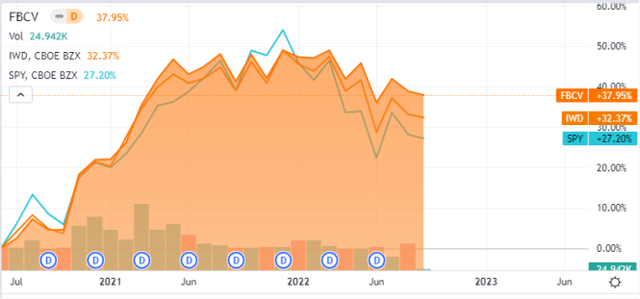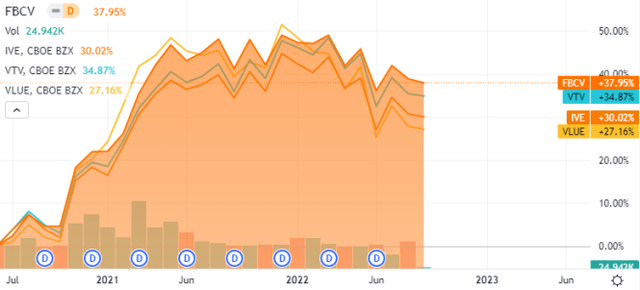[ad_1]
marlenka/iStock via Getty Images
FBCV strategy and portfolio
The Fidelity Blue Chip Value ETF (BATS:FBCV) is an actively managed ETF launched on 06/02/2020. It has a 12-month distribution yield of 3.47%, a total expense ratio of 0.59% and a net asset value about $114M. It pays quarterly distributions. As described in the prospectus by Fidelity, the fund is different from traditional ETFs:
It is not required to publicly disclose its complete portfolio holdings each business day. Instead, the fund publishes each business day on its website a “Tracking Basket,” which is designed to closely track the daily performance of the fund but is not the fund’s actual portfolio.
FBCV invests “in companies that FMR believes are undervalued in the marketplace in relation to factors such as assets, sales, earnings, growth potential, or cash flow, or in relation to securities of other companies in the same industry.”
To see the current tracking basket, follow this link. Its weight overlap with the real portfolio is 82%.
The portfolio turnover is quite high: 97% during the most recent fiscal year.
FBCV benchmark is the Russell 1000 Value Index. In this article, it will be compared to the iShares Russell 1000 Value ETF (IWD), and also to the SPDR S&P 500 Trust ETF (SPY). The usual valuation ratios are reported in the next table.
|
FBCV |
IWD |
SPY |
|
|
Price / Earnings TTM |
16.28 |
14.01 |
20.15 |
|
Price / Book |
2.28 |
2.08 |
3.85 |
|
Price / Sales |
1.54 |
1.67 |
2.55 |
|
Price / Cash Flow |
11.9 |
10.85 |
15.85 |
Source: Fidelity
FBCV is cheaper than SPY regarding the 4 ratios and a bit more expensive than IWD, except in price/sales.
Since inception in June 2020, FBCV has outperformed IWD and SPY by 5.6 and 10.7 percentage points, respectively (see next chart). This is share price performance excluding dividends.
FBCV vs. benchmarks (TradingView on SeekingAlpha)
The next chart compares FBCV with three other large and mid cap value ETFs by different issuers and based on different underlying indexes. FBCV still leads the pack.
FBCV vs. competitors (TradingView on SeekingAlpha)
Why is FBCV better? Value indexes usually rank all stocks on the same criteria. It means valuation ratios are considered comparable across sectors. Obviously they are not: you can read my monthly dashboard here for more details about this topic. A consequence is to privilege sectors where valuation ratios are naturally cheaper, especially financials. FBCV prospectus doesn’t tell much about the strategy, but it discloses that companies are compared to their peers in the same industry. The bias across all sectors and industries may not be completely fixed, but at least it is reduced.
Another shortcoming of value indexes comes from using the price/book ratio (P/B) as a main factor. Speaking of probabilities, a large group of companies with low P/B contains a higher percentage of value traps than a same-size group with low price/earnings, price/sales or price/free cash flow. Statistically, such a group will also have a higher volatility and deeper drawdowns in price. The next table shows the return and risk metrics of the cheapest quarter of the S&P 500 (i.e. 125 stocks) measured in price/book, price/earnings, price/sales and price/free cash flow. The sets are reconstituted annually between 1/1/1999 and 1/1/2022 with elements in equal weight.
|
Annual.Return |
Drawdown |
Sharpe ratio |
Volatility |
|
|
Cheapest quarter in P/B |
9.95% |
-72.36% |
0.48 |
21.05% |
|
Cheapest quarter in P/E |
11.25% |
-65.09% |
0.57 |
18.91% |
|
Cheapest quarter in P/S |
12.62% |
-65.66% |
0.6 |
20.46% |
|
Cheapest quarter in P/FCF |
12.23% |
-63.55% |
0.61 |
19.05% |
Data calculated with Portfolio123
FBCV is likely to use similar ratios, including one closely related to P/B. However, it also uses a “growth potential” criterion. It may be the PEG ratio or another metric using EPS growth or sales growth estimates. Anyway, it makes FBCV better than the usual value index ETFs by lowering the risk of picking value traps.
Takeaway
FBCV is an actively managed value ETF in a large and mid cap universe. It lacks the transparency of traditional ETFs: the strategy and holdings are not disclosed by Fidelity. Moreover, its asset value and average trading volume are low. Despite these drawbacks, it may be an attractive alternative to other large cap value ETFs. It has beaten its main competitors and the S&P 500 in the last 2 years, and it implements a smart concept of value taking into account industry and growth.
Source link






